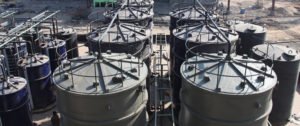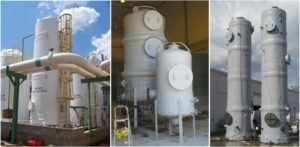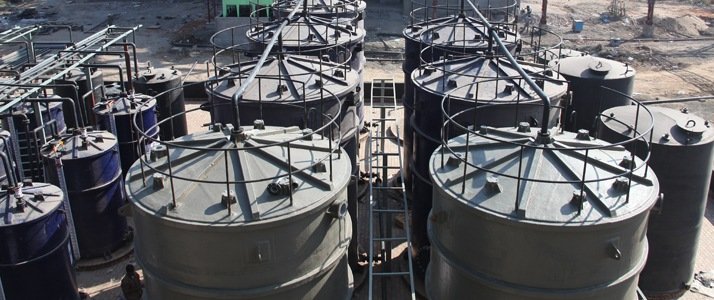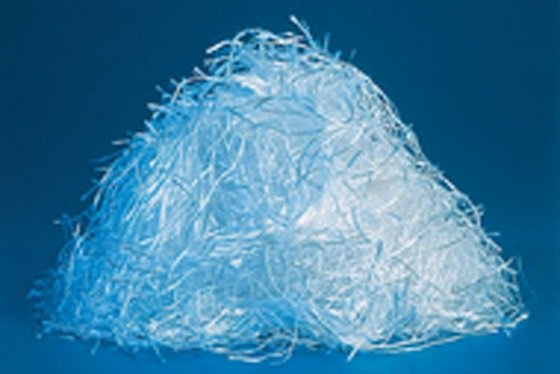HOW FIBRE REINFORCED PLASTICS USED TO MAKE TANK AND VESSELS
FRP (Fibreglass Reinforced Plastics, also known as GRP, or Glass Reinforced Plastics) is a modern composite material of construction for chemical plant equipment like tanks and vessels. Chemical equipment that range in size from less than a metre to 20 metres are fabricated using FRP as material of construction.
FRP Chemical Equipment’s are manufactured mainly by Hand Lay-up and filament winding processes. BS4994 still remains a key standard for this class of items.

DOUBLE LAYER LAMINATE:
Due to the corrosion resistant nature of FRP, the tank can be made entirely from the composite, or a second liner can be used. In either case, the inner liner is made using different material properties than the structural portion and laminate (a word commonly used for a layer of a composite material).
The liner, if made of FRP is usually resin rich and utilizes a different type of glass, called “C-Glass”, while the structural portion uses “E-Glass”. The thermoplastic liner is usually 2.3 mm thick (100 mils). This thermoplastic liner is not considered to contribute mechanical strength. The FRP liner is usually cured before winding or lay-up continues, by using either a BPO/DMA system, or using an MEKP catalyst with cobalt in the resin.
If the liner is not made of FRP, there are multiple choices for a thermoplastic liner. The engineer will need to design the tank based on the chemical corrosion requirement of the equipment. PP, PVC, PTFE, ECTFE, ETFE, FEP, CPVC, PVDF are used as common thermoplastic liners.
Due to FRP’s weakness to buckling, but immense strength against tensile forces and its resistance to corrosion, a hydrostatic tank is a logical application for the composite. The tank is designed to withstand the hydrostatic forces required by orienting the fibres in the tangential direction. This increases the hoop strength, making the tanks an-isotropically stronger than steel (pound per pound).
FRP which is constructed over the liner provides the structural strength requirements to withstand design conditions such as internal pressure or vacuum, hydrostatic loads, seismic loads (including fluid sloshing), wind loads, regeneration hydrostatic loads, and even snow loads.
Tanks:
A typical storage tank made of FRP has an inlet, an outlet, a vent, an access port, a drain, and an overflow nozzle. However, there are other features that can be included in the tank. Ladders on the outside allow for easy access to the roof for loading. The vessel must be designed to withstand the load of someone standing on these ladders, and even withstand a person standing on the roof. Sloped bottoms allow for easier draining. Level gauges allow someone to accurately read the liquid level in the tank. The vessel must be resistant to the corrosive nature of the fluid it contains.
The size of FRP Vessels is rarely limited by manufacturing technology, but rather by economics. Tanks smaller than 7,500 liters (2,000 gallons) are easily manufactured out of cheaper materials, such as HDPE or PVC. Tanks larger than four meters are generally limited by shipping constraints, and the economics suggest a concrete or steel tank fabricated at the tank’s location.
For chemical storage and air pollution control, the choice is to make multiple tanks of smaller diameters.
Typical FRP vessels and constructs limits are almost entirely based on the application parameters and resins used. The thermoplastic resin will suffer from creep at elevated temperatures and ultimately fail. However, new chemistry has produced resins that claim to be able to achieve even higher temperatures, which expand this field immensely. The typical maximum is 200 degrees Celsius.
Fiberglass vessels and constructs are also susceptible to degradation upon long-term exposure to sunlight. This deterioration is brought about by chemical changes which occur as a result of exposure to the ultraviolet (UV) portion of light. Degradation results in the fiberglass tanks and constructs, opening pores in the surface allowing styrene to wick out of the vessel or construct’s walls, causing them to become embrittled, reducing the impact resistance and potential elongation properties of the part.
Degradation from UV light can be effectively inhibited by the addition of exterior gelcoats and sealants, which protect the fiberglass construct through removing UV access to the product’s
surface thus deflecting UV energy. The UV life of a part is dependent upon UV additive level and type as well as part thickness and design, pigment type, level and effectiveness of dispersion, processing conditions and the geographic location where the molded part is used.
It is important when comparing resin UV performance to ensure that the testing has been done on a
consistent basis. Accelerated weathering data is presented. Generally, 2,000 hours corresponds to 1 year in Florida and 1,400 hours to 1 year in Southern Canada. Often terms like “UV-8” are used. UV-8 means the material can withstand 8,000 hours in a Xenon Ci-65 weatherometer. UV-2 or UV-4 would mean 2,000 or 4,000 hours respectively. Hence, UV-8 corresponds to approximately 4 years of continuous outdoor exposure in Florida.
It is important to understand which weatherometer, i.e. Carbon Arc or Xenon, was used, as well as the details of how the weatherometer was run. ASTM D-2565 is the recognized standard. Testing can be performed using actual outdoor weathering exposure, such as Florida and Arizona, to confirm this data.
Types of Tanks & Vessels:
FRP tanks and process vessels are used in various commercial and industrial applications, including chemical, water & wastewater, food & beverage, mining & metals, power, energy, and high-purity applications.
DESIGN STANDARDS:
- Bs4994-87 is the British Standards Standard for FRP Tanks and Vessels superseded by EN 13121.
- ASME RTP-1 (Reinforced Thermoset Plastic Corrosion Resistant Equipment) is the standard for FRP tanks and vessels held within the United States under 50 psi and located partially or fully above ground.
- ASTM 3299 which is only a product specification, governs the filament winding process for tanks. It is not a design standard.
- SS245:1995 Singapore Standard for Sectional GRP Water Storage Tanks.
What is BS 4994?
BS 4994 is a standard of specifications which is used for make FRP tanks. It is to avoid the uncertainty associated with specifying the thickness alone, that BS4994 introduced the concept of
“unit properties”. It is property per unit width, per unit mass of reinforcement. For example, UNIT STRENGTH is defined as load in Newton per millimetre (of laminate width) for a layer consisting of 1 kg of glass per square meter. i.e. the unit is N/mm per Kg/m2 glass.
ASME RTP-1
In RTP-1 specifications, the primary concerns relate stress and strain, such as hoop stress, axial stress, and breaking stress to the physical properties of the material, such as Young’s modulus (which may require an anisotropic analysis due to the filament winding process). These are related to the loads of the design, such as the internal pressure and strain.
BS EN-13121
This European standard replaces BS4994-87 which is marked now as Current, Obsolescent, Superseded.
SS-245-1995
This is the Singapore Standard for sectional GRP water tank, which is current.
Application of FRP tanks & Vessels:

FRP tanks and vessels designed as per BS 4994 are widely used in the chemical industry in the following sectors: chlor-alkali manufacturers, fertilizer, wood pulp and paper, metal extraction, refining, electroplating, brine, vinegar, food processing, and in air pollution control equipment, especially at municipal waste water treatment plants and water treatment plants.





official statement
I really like your blog.. very nice colors & theme. Did you design this website yourself or did you hire
someone to do it for you? Plz respond as I’m looking to design my
own blog and would like to know where u got this from.
appreciate it https://goo.gl/65iVAX
thank u so much for your appreciation. this website design and decorated by me only. also you can design because here is no harden and faster
Nice weblog right here! Also your site rather a lot up fast!
What host are you the use of? Can I am getting your affiliate link for your host?
I want my site loaded up as fast as yours lol
My hosting affiliate link
https://m.do.co/c/ceb8220180bf
dear sir/madam,
I required the recipe of resin (winding) used in the formation of frp tank.
Hello admin
Your article is totally different so keep it up !!
Pl call back . Am interested to discuss on subject . My mobile no 8105218929
[…] FRP units should be stored far away from your other equipment to reduce the chances of […]
This vessel services is Good